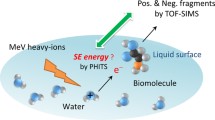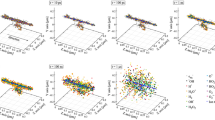Abstract
Time-dependent yields of the most important products of water radiolysis \( {\text{e}}_{\rm {aq}}^-\), •OH, H•, H3O+, H2, OH− and H2O2 have been calculated for 60Co-photons, electrons, protons, helium- and carbon-ions incident onto water. G values have been evaluated for the interval from 1 ps to 1 μs after initial energy deposition as a function of time, as well as after 1 ns and at the end of the chemical stage as a function of linear energy transfer (LET), covering an interval from approximately 0.2 up to 750 keV/μm by means of different particle types. In this work, the modules of the biophysical Monte Carlo track structure code PARTRAC dealing with the simulation of prechemical and chemical stages have been improved to extend interaction data sets for heavier ions. Among other newly selected parameter values, the thermalisation distance between the point of generation and hydration of subexcitation electrons has been adopted from recent data in the literature. As far as data from the literature are available, good agreement has been found with the calculated time- and LET-dependent yields in this work, supporting the selection of the revised parameter values.






Similar content being viewed by others
References
Paretzke HG (1987) Radiation track structure theory. In: Freeman GR (ed) Kinetics of nonhomogeneous processes. Wiley, New York, pp 89—170
Friedland W, Jacob P, Paretzke HG, Merzagora M, Ottolenghi A (1999) Simulation of DNA fragment distributions after irradiation with photons. Radiat Environ Biophys 38:39–47
Dingfelder M, Hantke D, Inokuti M, Paretzke HG (1998) Electron inelastic-scattering cross sections in liquid water. Radiat Phys Chem 53:1–18
Dingfelder M, Ritchie RH, Turner JE, Friedland W, Paretzke HG, Hamm RN (2008) Comparisons of calculations with PARTRAC and NOREC: transport of electrons in liquid water. Radiat Res 169:584–594
Dingfelder M, Inokuti M, Paretzke HG (2000) Inelastic-collision cross sections of liquid water for interaction of energetic protons. Radiat Phys Chem 59:255–275
Dingfelder M, Jorjishvili IG, Gersh JA, Toburen LH (2006) Heavy ion track structure simulations in liquid water at relativistic energies. Radiat Prot Dosimetry 122:26–27
Friedland W, Jacob P, Bernhardt P, Paretzke HG, Dingfelder M (2003) Simulation of DNA damage after proton irradiation. Radiat Res 159: 401–410
Friedland W, Dingfelder M, Jacob P, Paretzke HG (2005) Calculated DNA double-strand break and fragmentation yields after irradiation with He ions. Radiat Phys Chem 72:279–286
Friedland W, Jacob P, Paretzke HG, Ottolenghi A, Ballarini F, Liotta M (2006) Simulation of light ion induced DNA damage patterns. Radiat Prot Dosimetry 122:116–120
Ballarini F, Biaggi M, Merzagora M, Ottolenghi A, Dingfelder M, Friedland W, Jacob P, Paretzke HG (2000) Stochastic aspects and uncertainties in the prechemical and chemical stages of electron tracks in liquid water: a quantitative analysis based on Monte Carlo simulations. Radiat Environ Biophys 39:179–188
Valota A, Ballarini F, Friedland W, Jacob P, Ottolenghi A, Paretzke HG (2003) Modelling study on the protective role of OH radical scavengers and DNA higher-order structures in induction of single- and double-strand breaks by gamma-radiation. Int J Radiat Biol 79:643–653
Friedland W, Paretzke HG, Ballarini F, Ottolenghi A, Kreth G, Cremer C (2008) First steps towards systems radiation biology studies concerned with DNA and chromosome structure within living cells. Radiat Environ Biophys 47:49–61
Cullen DE, Hubbell JH, Kissel L (1997) EPDL97: the evaluated photon data library, ’97 version. Lawrence Livermore National Laboratory UCRL-50400, vol 6, Rev. 5
Ogura H, Hamill WH (1973) Positive hole migration in pulse-irradiated water and heavy water. J Phys Chem 77:2952–2954
Tomita H, Kai M, Kusama T, Ito A (1997) Monte Carlo simulation of physicochemical processes of liquid water radiolysis. The effects of dissolved oxygen and OH scavenger. Radiat Environ Biophys 36:105–116
Cobut V, Frongillo Y, Patau JP, Goulet T, Fraser MJ, Jay-Gerin JP (1998) Monte Carlo simulation of fast electron and proton tracks in liquid water. I. Physical and physicochemical aspects. Radiat Phys Chem 51:229–243
Hill A, Smith FA (1994) Calculation of initial and primary yields in the radiolysis of water. Radiat Phys Chem 43:265–280
Turner JE, Hamm RN, Wright HA, Ritchie RH, Magee JL, Chatterjee A, Bolch WE (1988) Studies to link the basic radiation physics and chemistry of liquid water. Radiat Phys Chem 32:503–510
Dayashankar, Prasad MA (1995) Effect ion migration on recombination of subexcitation electrons in solid water. Radiat Phys Chem 45:147–149
Burns WG, Marsh WR (1981) Radiation chemistry of high-temperature (300–410°C) water. Part 1. Reducing products from gamma radiolysis. J Chem Soc Faraday Trans 1 77:197–215
Michaud M, Sanche L (1987) Total cross sections for slow-electron (1–20 eV) scattering in solid H2O. Phys Rev A 36:4672–4683
Michaud M, Sanche L (1987) Absolute vibrational excitation cross sections for slow-electron (1–18 eV) scattering in solid H2O. Phys Rev A 36:4684–4699
Goulet T, Jay-Gerin JP (1988) Thermalization distances and times for subexcitation electrons in solid water. J Phys Chem 92:6871–6874
Kevan L (1981) Geometrical structure of solvated electrons. Radiat Phys Chem 17:413–423
Meesungnoen J, Jay-Gerin JP, Filali-Mouhim A, Mankhetkorn S (2002) Low-energy electron penetration range in liquid water. Radiat Res 158:657–660
Terrissol M, Beaudre A (1990) Simulation of space and time evolution of radiolytic species induced by electrons in water. Radiat Prot Dosimetry 31:171–175
Goulet T, Patau JP, Jay-Gerin JP (1990) Influence of the parent cation on the thermalization of subexcitation electrons in solid water. J Phys Chem 94:7312–7316
Berg HC (1992) Random walks in biology. Princeton University Press, Princeton
Frongillo Y, Goulet T, Fraser MJ, Cobut V, Patau JP, Jay-Gerin JP (1998) Monte Carlo simulation of fast electron and proton tracks in liquid water. II. Nonhomogeneous chemistry. Radiat Phys Chem 51:245–254
Noyes RM (1961) Effects of diffusion rate on chemical kinetics. In: Porter G, Stevens B (eds) Progress in reaction kinetics, vol 1. Pergamon, New York, pp 129–160
Buxton GV, Greenstock CL, Helman WP , Ross AB (1988) Critical review of rate constants for reactions of hydrated electrons, hydrogen atoms and hydroxyl radicals (•OH/•O−) in aqueous solution. J Phys Chem Ref Data 17:513–886
Hamm RN, Turner JE, Stabin MG (1998) Monte Carlo simulation of diffusion and reaction in water radiolysis—a study of reactant ‘jump through’ and jump distances. Radiat Environ Biophys 36:229–234
Bisby RH, Cundall RB, Sims HE, Burns WG (1977) Linear energy transfer (LET) effects in the radiation-induced inactivation of papain. Faraday Discuss Chem Soc 63:237–247
Trumbore CN, Short DR, Fanning JE, Olson JH (1978) Effects of pulse dose on hydrated electron decay kinetics in the pulse radiolysis of water. A computer modeling study. J Phys Chem 82:2762–2767
Naleway CA, Sauer MC Jr, Jonah CD, Schmidt KH (1979) Theoretical analysis of the LET dependence of transient yields observed in pulse radiolysis with ion beams. Radiat Res 77:47–61
Turner JE, Magee JL, Wright HA, Chatterjee A, Hamm RN, Ritchie RH (1983) Physical and chemical development of electron tracks in liquid water. Radiat Res 96:437–449
Kaplan IG, Miterev AM, Sukhonosov VYA (1990) Simulation of the primary stage of liquid water radiolysis. Radiat Phys Chem 36:493–498
Pimblott SM, LaVerne JA (1994) Diffusion-kinetic theories for LET effects on the radiolysis of water. J Phys Chem 98:6136–6143
Pimblott SM, LaVerne JA (1997) Stochastic simulation of the electron radiolysis of water and aqueous solutions. J Phys Chem 101:5828–5838
LaVerne JA (2000) OH radicals and oxidizing products in the gamma radiolysis of water. Radiat Res 153:196–200
Jonah CD, Hart EJ, Matheson MS (1973) Yields and decay of the hydrated electron at times greater than 200 picoseconds. J Phys Chem 77: 1838–1843
Jonah CD, Matheson MS, Miller JR, Hart EJ (1976) Yield and decay of the hydrated electron from 100 ps to 3 ns. J Phys Chem 80:1267–1270
Jonah CD, Miller JR (1977) Yield and decay of the OH radical from 200 ps to 3 ns. J Phys Chem 81:1974–1976
Buxton GV (1972) Nanosecond pulse radiolysis of aqueous solutions containing proton and hydroxyl radical scavengers. Proc R Soc Lond A Math Phys Sci 328:9–21
Shiraishi H, Katsumura Y, Hiroishi D, Ishigure K, Washio M (1988) Pulse-radiolysis study on the yield of hydrated electron at elevated temperatures. J Phys Chem 92:3011–3017
LaVerne JA, Pimblott SM (1991) Scavenger and time dependences of radicals and molecular products in the electron radiolysis of water: examination of experiments and models. J Phys Chem 95:3196–3206
Stabin MG, Hamm RN, Turner JE, Bolch WE (1994) Track structure simulation and determination of product yields in the electron radiolysis of water containing various solutes. Radiat Prot Dosimetry 52: 255–258
Elliot AJ, Chenier MP, Ouellette DC (1993) Temperature dependence of g values for H2O and D2O irradiated with low linear energy transfer radiation. J Chem Soc Faraday Trans 89:1193–1197
Appleby A, Schwarz HA (1969) Radical and molecular yields in water irradiated by γ rays and heavy ions. J Phys Chem 73:1937–1941
Meesungnoen J, Benrahmoune M, Filali-Mouhim A, Mankhetkorn S, Jay-Gerin JP (2001) Monte Carlo calculation of the primary radical and molecular yields of liquid water radiolysis in the linear energy transfer range 0.3–6.5 keV/μm: application to 137Cs gamma rays. Radiat Res 155:269–278
McCracken DR, Tsang KT, Laughton PJ (1998) Aspects of the physics and chemistry of water radiolysis by fast neutrons and fast electrons in nuclear reactors, Report AECL-11895. Atomic Energy of Canada Ltd, Chalk River
Katz R (1970) RBE, LET and z/βα. Health Phys 18:170
Burns WG, Sims HE (1981) Effect of radiation type in water radiolysis. J Chem Soc Faraday Trans 77:2803–2813
Wasselin-Trupin V, Baldacchino G, Bouffard S, Hickel B (2002) Hydrogen peroxide yields in water radiolysis by high-energy ion beams at constant LET. Radiat Phys Chem 65:53–61
Pastina B, LaVerne JA (1999) Hydrogen peroxide production in the radiolysis of water with heavy ions. J Phys Chem A 103:1592–1597
Meesungnoen J, Jay-Gerin JP (2005) High-LET radiolysis of liquid water with 1H+, 4He2+, 12C6+, and 20Ne9+ ions: effects of multiple ionization. J Phys Chem A 109: 6406–6419
Liljequist D (2008) A study of errors in trajectory simulation with relevance for 0.2–50 eV electrons in liquid water. Radiat Phys Chem 77:835–853
Acknowledgments
This work has partially been supported by the EU (RISC-RAD, Contract no. FI6R-CT-2003-508842). This work also contributes to problems dealt within the excellence cluster ‘Munich-Centre for Advanced Photonics’ (MAP).
Author information
Authors and Affiliations
Corresponding author
Rights and permissions
About this article
Cite this article
Kreipl, M.S., Friedland, W. & Paretzke, H.G. Time- and space-resolved Monte Carlo study of water radiolysis for photon, electron and ion irradiation. Radiat Environ Biophys 48, 11–20 (2009). https://doi.org/10.1007/s00411-008-0194-8
Received:
Accepted:
Published:
Issue Date:
DOI: https://doi.org/10.1007/s00411-008-0194-8




